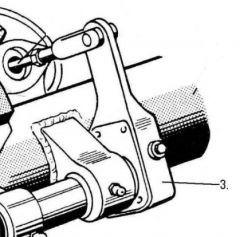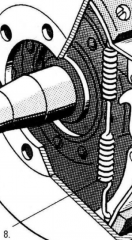![]()
![]()
![]()
Use LEFT and RIGHT arrow keys to navigate between flashcards;
Use UP and DOWN arrow keys to flip the card;
H to show hint;
A reads text to speech;
48 Cards in this Set
- Front
- Back
- 3rd side (hint)
|
1.To keep a Forest Service engine with a full tank of water ready during freezing weather, which valve/valves should be closed? |
1,2,13,(15 volume),17,18 |
A. 1,2,17 B. 1,2,13,15(v),17,18 C. 11 D. 3,8 |
|
|
2.How many inches of vacuum are necessary to lift water six feet? |
6 hg |
A. 10 inches
B. 8 inches C. 12 inches D. 6 inches |
|
|
3. A Model 62 engine has what kind of pump |
2 stage centrifugal pump |
A. Single stage positive displacement pump B. 2 stage centrifugal pump C. 4 stage centrifugal pump D. 3 stage positive displacement pump |
|
|
4. A positive displacement pump should have apressure relief valve. |
True |
A. True B. False
|
|
|
5. What do the following abbreviations mean? GVWR- NPSH- NH- GPM- PSI- CJRL- |
GVWR-gross vehicle weight rating NPSH-national pipe standard hose NH-national hose GPM-gallon per minute PSI-Pounds per square inch CJRL- cotton jacket rubber lined hose WCF - working capital fund |
|
|
|
6. When testing fire hose, the total length of each line tested shall not exceed? |
300 feet @ 300 psi for 3 minutes |
A, 300 feet B, 150 feet C, 100 feet D, any length needed |
|
|
7. the pump on a model 62 type 3 engine is rated at _______ gpm @ _________ psi |
400 GPM @ 150 PSI pressure 200 GPM @ 400 PSI volume |
|
|
|
8. How many gallons of water are contained in a 100 foot section of 1 1/2 inch hose? |
9.2 gallon |
A. 12 gallons
B. 5.1 gallons C. 7.4 gallons D. 9.2 gallon |
|
|
9. One psi lifts water _______ feet |
2 feet |
A. 1
B. 2 C. 3 D. 4 |
|
|
10.Explain friction loss |
when moving water comes in contact with the inner lining of the hose, a loss of energy will occur due to friction |
|
|
|
11. The friction loss in 1-inch hose is approximately 6 times greater than 1 1/2inches of hose |
false its 7 times greater |
A. true B. False
|
|
|
12. Friction loss decreases as flow ___________.(GPM) |
decreases |
|
|
|
13. A "Floto-pump" is a self priming pump and can be started before it is set in water. |
True |
A. True B. False
|
|
|
14. When drafting from a stream, the suction screen should be deep enough to maintain a prime. |
True-16 to 18 inches |
A. True B. False |
|
|
15. Which of the following conditions can cause cavitation in a fire pump? |
High demand on the nozzles A blocked or inadequate suction strainer. Using too small or too long of section hose Clog strainer |
A. Rising water temperature in your pump B. A blocked or inadequate suction strainer C. Using too small or too long of section hose D. All of the aboveE. None of the above |
|
|
16. After off road use with an engine, it is advisable to check for rocks between the duals and for possible tire sidewall damage. |
True |
A. True B. False
|
|
|
17. A backup person is only required when you cannot see behind the engine. |
False |
A. True B. False
|
|
|
18. Name the number one priority in all fire service. |
Life & safety |
A. Life / safety
B. Property protection C. Resource protection D. hazard pay |
|
|
19. Diesel engines are just naturally oily so leaks are to be expected. |
False |
A. True B. False
|
|
|
20. Pick the best answer: what is the probable cause of a "howling, squealing" fan belt? |
Belt is loose |
A. Belt is loose
B. Belt is dirty C. Belt is cracked D. None of the above |
|
|
21. What kind of contamination in the fuel system is the "typical" cause of diesel engine failure? |
Water |
A. Oil
B. Water C. Other fuel |
|
|
22. What are four items to check during a pre use inspection (pick the best answer)? |
Tires, lights/signals, engine oil level, coolant level in radiator, |
A. Tires, lights/signals, engine oil level, coolant level in radiator,
B. Windshield wipers, tires, map kit, equipment maintenance log, radio C. Brakes, driver's license, first aid kit, windows |
|
|
23. Which one of the below is not part of leader's intent (according to the IRPG)? |
Direction |
A. End state B. Task C. Direction D. Purpose |
|
|
24. Which of the following is not part of the risk management process (according to the IRPG)? |
Hazard avoidance |
A. Evaluate
B. Hazard control C. Decision point D. Hazard assessment E. Situation awareness F. Hazard avoidance |
|
|
25. By adding a surfactant to water we are able to lower the ________ of water. |
surface tension |
|
|
|
26. List the three properties of foam. |
A. smothering the fire B.separates the flames/ignition source from the fuel surface. C. suppresses the release of flammable vapors that can mix with air D.cools |
|
|
|
27. Match the application to the type of foam(s) best suited for the work (choose all that apply). |
Direct attack _ A.Foam solution indirect attack _B.wet foam mop up _C. fluid foam structure protection _D.dry foam |
Direct attack ___ indirect attack ___ mop up ___ structure protection ___ |
|
|
28. Utilizing the model naming convention, what do the 3 digits of a model 346 type 3 engine signify? |
A. 3 = type B. 4 = 4 wheel or 2 wheel drive C. 6 = gallons |
|
|
|
29.To pump water through a 1-1/2” line from a pond to a fire, what valves must be opened
|
8-3-19
|
|
|
|
30. How many gallons of water are contained in a 100 foot section of 1 inch hose? |
4 gallons |
A. 6 gallons B. 5.1 gallons C. 4 gallons D. 9.2 gallon |
|
|
31.What is the atmospheric pressure at sea level on a standard day?
|
14.7 pounds per square inch (psi)
|
|
|
|
32.According to the NWCG National Incident Operations Driving Standard, multiple drivers can driveup to the duty day limitation as long as no single driver exceeds____ hours behind the wheel. |
10 |
|
|
|
33.____________ systems are designed to provide improved vehicle stability by reducing wheel lockor wheel slip during conditions of aggressive braking or impaired traction
|
Anti-Lock Braking (ABS)
|
A. Anti-Compounding
B. Automatic Transmission C. Cruise Control D. Secondary Braking E. Anti-Lock Braking (ABS) |
|
|
34. On a green arrow, you must: |
Yield to any vehicle, bicycle, or pedestrian |
A. Yield to any vehicle, bicycle, or pedestrian B. Yield to pedestrians only in the intersection C. Wait 4 seconds before proceeding |
|
|
Newton's first law of motion |
Every object in a state of uniform motion tends to remain in that state of motion unless an external force is applied to it. |
|
|
|
Newton second law of motion |
A body will accelerate with acceleration proportional to the force and inversely proportional to the mass. |
|
|
|
Newton's third law of motion |
For every action there is an equal and opposite reaction.
|
|
|

|
Push Rod |
|
|

|
Axle housing |
|
|

|
slack adjuster |
|
|

|
Brake cam (s-cam) |
|
|

|
Cam roller |
|
|

|
Brake Shoe |
|
|

|
Brake Shoe Lining |
|
|

|
Return Spring |
|
|

|
Brake Drum |
|
|

|
Axle |
|
|
|
how much does 1 gallon of water weigh |
8.34 |
|

